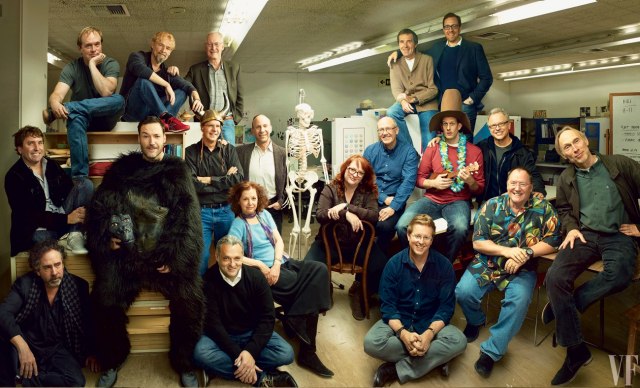THE KIDS FROM CALARTS From left: Steve Hillenburg, Tim Burton, Brad Bird, Mark Andrews (in ape suit), Jerry Rees, Chris Buck (with Viking helmet), John Musker, Genndy Tartakovsky, Leslie Gorin, Mike Giaimo, Brenda Chapman, Glen Keane, Kirk Wise (in beige sweater), Andrew Stanton, Pete Docter (with Lei), Rob Minkoff, Rich Moore, John Lasseter, and Henry Selick, in the famed CalArts classroom A113.
Vanity Fair photos by ANNIE LEIBOVITZ.
Very interesting article from Vanity Fair about the very talented Cal Arts students that went on to do so much. I worked with Jerry Rees when I was at Walt Disney Imagineering. His is a very talented guy and is best known for the delightful Brave Little Toaster.
Quotes from the article I liked;
Room A113 was where many of the Character Animation classes took place. “CalArts didn’t give us the best rooms of the house, shall we say,” recalls Beiman. “We used to joke that it was like the Haunted Mansion—it had no windows and no door. […] Yet the windowless room became a kind of inside joke, later cropping up in several animated films: In The Brave Little Toaster, it’s the apartment number where the Master lives; in Toy Story, it’s the license-plate number on Andy’s mom’s car; in Toy Story 2, there’s an announcement for LassetAir Flight A113; in Ratatouille, the lab rat, Git, wears a tag on his ear that reads “A113”; in Cars, it’s the headcode on Trev Diesel, the freight train; in Finding Nemo, it’s the model number on the camera used by the scuba-diver; it even appears in Roman numerals in Brave.
[…]
One roseate memory for all of the inaugural class was being able to look through the great stacks of animated drawings from the great Disney animators. They would study the drawings, then flip them to check the motion. Lasseter, for example, would spend hours studying the drawings. “I remember individual sequences so vividly they jump to mind almost as often as the images from the films: Frank Thomas’s Lady and the Tramp eating spaghetti; Ollie Johnston’s drawings of Bambi learning to walk; Milt Kahl’s Madame Medusa peeling off her fake eyelashes; Marc Davis’s flamboyant Cruella de Vil.”
[…]
“There was this avant-garde wing, and then there were these kids who were more interested in Star Trek than Rothko,” recalls Selick. According to Giaimo, “There was also a schism philosophically, in terms of how one led one’s life…. In the character department there was a conservative bent, generally. We loved animation. We were devoted to it. It took a lot of study, and it took total immersion.” “It was like warring tribes,” Burton explains. “I think the only person who moved between the two was Henry Selick.”
Brad Bird was aware that the experimental side looked upon the Character Animation Program as “more corporate. I mean, some members of the film school and the art school considered us barely above greeting cards, you know? I don’t think they understood that what we were getting was a classical education applicable in more different ways than they realized. You learned how to read sound, you learned how to cut film, you learned how to calculate camera moves on a camera stand, you learned about life drawing, and you learned about light and shadow and how you can orchestrate color.”
[…]
“Marc Davis was one of the Nine Old Men of animation,” recalls Giaimo. “He was a Renaissance man at Disney. He helped design concepts for the theme parks. He animated, oh, my God, Cinderella, Tinker Bell, Cruella de Vil, Maleficent in Sleeping Beauty. He was an amazing animator, an amazing draftsman, brilliant designer.”
[…]
“T. Hee directed the ‘Dance of the Hours’ sequence in Fantasia. He taught us caricature and character design and other stuff, but his class was more than that. He just wanted you to think creatively.” Nearly four decades later, Trousdale still remembers one of T. Hee’s provocative assignments: taping sketch paper under a table and drawing “blind and upside down.” T. Hee also herded his students into a theater for a day to watch animated commercials. “That was eye-opening,” says Trousdale. “Those commercials were telling a story, with a beginning, middle, and end, in 30 seconds. It was a discipline—you had to be clear and concise.”
[…]
One of the bohemian girls from the art school volunteered to be a life model, and to torture the kind of nerdy, Star Trek-loving boy artists, she posed nude wearing a Mouseketeer hat.
[…]
They called it “the rat’s nest,” the room where the new animators were put to work. “It was like too much nuclear energy packed into the tiny little capsule of the Disney Animation Studio,” describes Glen Keane (supervising animator on Beauty and the Beast and Aladdin), a greatly admired Disney animator who had studied at CalArts. “It just could not contain that kind of passion. It was this hotbed of discontent because they wanted so much more—eventually it exploded.”
[…]
In fact, Burton was doing remarkable work there, sealed off in a tiny room in the animation building. Remembers Brad Bird, who moved to Disney after two years at CalArts, “He did these amazing designs for Black Cauldron that were better than anything they had in the movie—he did these griffins that actually had claws for mouths, and they were really great and really scary, in the best way.
Also, Watch John Lasseter’s and Andrew Stanton’s CalArts Student Films
